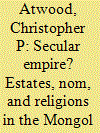| Srl | Item |
| 1 |
ID:
135773


|
|
|
|
|
| Summary/Abstract |
Throughout their history, Inner Asian empires used familiar imperial institutions to rapidly impose new ethnic designations and their attendant languages, such as ‘Türk’ or ‘Mongol’, on their subjects. The swiftness of this integration into new ethnic designations should not be taken to mean that this integration was painless, however. In the well-documented Mongol empire, for example, this incorporation was extremely traumatic for many Inner Asian ethnic groups, even where the subordinate local elites achieved high status in the new regime. This may be seen in the case of the Öng’üt, a Christian Turkic-speaking people of Inner Mongolia whose rulers then became key marriage partners of the Mongol aristocracy. Successive iterations of the origin story of the Öng’üt rulers show how these histories went through vast changes as they were forcibly incorporated into the new empire, and dealt with the internal conflicts sparked by that incorporation. Previously central parts of their historic past, such as Christianity and service as border guards to the previous Jin dynasty, had to be marginalized and a new historical past had to be created. Historiography thus reflected and shaped changes in ethnic identity in a traumatic dynastic transition.
|
|
|
|
|
|
|
|
|
|
|
|
|
|
|
|
| 2 |
ID:
184154


|
|
|
|
|
| Summary/Abstract |
Recent work in religious studies has emphasized how European colonial empires used the defining and constructing of religions and secularism as tools of rule. This article explores parallel processes in the Mongol empire (1206–1368) where ‘religion-making’ occurred in three areas: 1) a precise and legal definition of professional service estates among the conquered peoples that included the clergies of designated religions; 2) a broad and imprecise classification of nom or ‘way of life’ that partially overlapped with the clergies defined in the first category; and 3) a realm above all such sectarian distinctions destined for the Mongol ruling elite who alone were capable of living in free obedience to Heaven. The parallels and differences with classifications of the religious and the secular in European colonial empires shed light on how power interacts with cultural classification and practices.
|
|
|
|
|
|
|
|
|
|
|
|
|
|
|
|